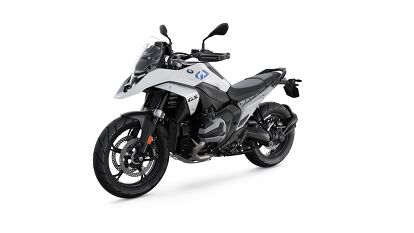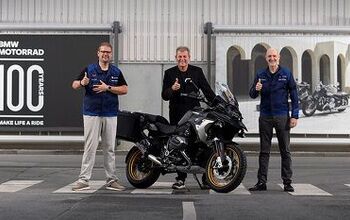2024 BMW R 1300 GS First Look

More power and less weight for BMW’s flagship GS
BMW has officially announced the R 1300 GS, introducing a new Boxer engine, updated suspension, radar-based safety systems and a 26-pound weight reduction compared to the R 1250 GS. Arriving in U.S. dealerships in early 2024, the BMW R 1300 GS will carry a price tag of $18,895 plus destination fees.
As we saw from the photos that leaked last week, the R 1300 GS has a new, less industrial-looking design that highlights its compactness and lighter weight. You still have the GS’ familiar beak-style fender, but if you follow its bottom edge back, it lines up with a much flatter tank.
The steel trellis frame from the last few generations of GS models is gone, with a new steel sheet metal shell frame and die-cast aluminum subframe. According to BMW, the new chassis offers greater levels of stiffness while significantly optimizing the use of space, contributing to the R 1300 GS’ more compact appearance. The subframe in particular was designed to reduce weight while also offering a variety of customization options, from luggage racks, top case holders, rear radar sensors and different seat options.
Up front, BMW has done away with the GS’ signature asymmetric headlights, replacing it with a new X-shaped matrix, full LED headlamp. Matrix LEDs use a combination of light elements and mirrors to control the light beam. In the GS’ case, it integrates the high and low beams into a single projector unit, and with the optional Headlight Pro upgrade, the headlight becomes adaptive, adjusting the light cone to compensate for lean angle and point the beam in the direction the motorcycle is turning.
BMW developed a brand new Boxer engine for the GS, with a 106.5 mm bore and 73 mm stroke that pushes the displacement to an even 1,300cc. That’s a larger cylinder bore than the 1,254cc engine’s 102.5 mm, but a shorter stroke than the previous 76 mm. Despite speculation about a fully liquid-cooled system, the engine continues to use a combination of air and liquid cooling, with coolant directed to the areas under the most thermal stress such as cylinder heads.
The engine also retains the ShiftCam variable valve timing system from the previous engine, offering both a partial-load cam for better fuel economy and a full-load cam for optimized performance. The new engine uses 44 mm intake valves and 35.6 mm exhaust valves, a significant increase from the old engine’s 44.0 mm intake and 34 mm exhaust valves. The compression ratio was also increased to 13.3:1 from the previous 12.5:1.
As a result of these changes, BMW claims a maximum output of 145 hp at 7,750 rpm and 110 lb-ft. at 6,500 rpm, compared to the R 1250 GS’ claimed 136 hp at 7,750 rpm and 105 lb-ft. at 6,250 rpm. Beyond the peak numbers, BMW claims a “notable” torque increase across the rev range, but especially between 3,600 and 7,800 rpm, where BMW claims the torque output stays above 96 lb-ft. The engine is paired with a 2-in-1 stainless steel exhaust designed to optimize output while keeping its weight low. BMW claims the engine is the most powerful serial production Boxer the company has ever produced, and we look forward to seeing it adopted on other R models.
With the new engine, BMW designed a new transmission, integrating the clutch and gearbox under the engine instead of behind it. With this new layout, BMW was able to reduce the overall length of the powertrain and reduce weight thanks to the use of significantly shorter transmission shafts. BMW was able to reduce the engine’s weight by 8.6 pounds, and the whole powertrain by 14.3 pounds. The wet clutch 10-disc clutch with anti-hopping mechanism is similar to the previous unit, while the gearbox has a new sensor signal transmitter for a more direct feel when upgraded with the optional Shift Assistant Pro.
BMW also updated the driveshaft with larger universal joints and a reduced angle to help mitigate some of the rotational inertia of a cardan shaft. The rear wheel axle has also been redesigned with a longer axle stub for easier mounting and dismounting of the wheel.
The R 1300 GS comes standard with four ride modes: Rain, Road, Eco, and Enduro. An optional Riding Modes Pro upgrade adds Dynamic, Dynamic Pro and Enduro Pro ride modes. Engine drag torque control, dynamic traction control, dynamic brake assist, hill hold control, and full integral ABS Pro all come standard.
A new radar system allows for the optional Riding Assistant, which includes adaptive cruise control, front collision warning, and lane change warning. Adaptive cruise control (Active Cruiser Control, BMW-speak) electronically adjusts the cruise control to maintain a minimal distance from the vehicle directly in front. Front collision warning applies some brake intervention to help avoid collisions, or at least help reduce their severity. Lane change warning uses a rear-facing radar sensor to monitor the back, including the blind spots, and lights up a symbol on the respective mirror to show when it is not safe to change lanes.
The new GS comes with the new EVO Telelever and EVO Paralever, the latest versions of BMW’s suspension systems.
Typically, a Telelever suspension has the upper fork bridge clamped directly to the fork tube. This inherently creates some tilting movement on the upper fork bridge. For sportier motorcycles, this isn’t very noticeable because of their shorter handlebars, but on the GS, however, with its high handlebars and longer suspension, the tilting movement would create problems. To compensate, BMW would use bearings on the upper fork bridge and fork legs’ swivel connection, mitigating the tilting, at the expense of stiffness.
The new EVO Telelever addresses that weakness, keeping a rigid connection as in the sportier setup, and adding a stainless steel plate as a handlebar bridge. The plate is designed to serve as a “flex element,” compensating for the tilting movement while still being able to transmit steering forces to the front end.
The EVO Paralever was revised to offer a stiffer connection to the frame. The swingarm now has a quick-release axle and the swingarm bearing was realigned with the axis of rotation of the cardan shaft joint.
The suspension still provides the same 7.5 inches of front and 7.9 inches of rear suspension as the R 1250 GS. For a bit more travel, BMW is introducing a new sports suspension system that adds 0.8 inches of spring travel front and rear, with a firm setup designed for off-road riding.
BMW also updated the optional dynamic suspension adjustment (DSA) system, combining the dynamic adjustment of the front and rear damping with a corresponding preload adjustment. Additionally, BMW is introducing a new adaptive vehicle height control system that automatically lowers the seat height at slow speeds or when stopped from the standard 33.5 inches to 32.3 inches.
The front wheel is equipped with dual disc brakes with new radially-mounted four-piston fixed calipers, while the rear wheel uses a single disc with a two-piston floating caliper. With the Full Integral ABS, activating either the hand lever or the foot pedal will now activate both front and rear brakes simultaneously. For off-road use, the ABS Pro settings can be changed to let the foot lever lock the rear wheel.
The R 1300 GS comes with a 6.5-inch TFT color display and BMW’s standard multi-controller. The screen is equipped with Bluetooth for connecting to smartphones or helmet communicators. A free BMW Motorrad Connected phone app adds navigation to the display.
For 2024, BMW offers four variations of the R 1300 GS. The basic variant in Light White comes with a compact Sport windshield, wide handlebars, and a slim passenger seat with grab handle. The basic model starts at $18,895.
The Triple Black variant adds comfort seats, more comfortable passenger pegs, a center stand, and an electronically adjustable windscreen. The Triple Black package adds $975, raising the price to $19,870.
The GS Trophy variant comes in a sporty Racing Blue Metallic with red highlights and a White Metallic Matte rear frame. The GS Trophy adds a rally seat which increases the height to 34.2 inches, and comes standard with radiator guards and cross-spoke wheels. Like the Triple Black variant, the GS Trophy comes in at $19,870 before adding any other packages or upgrades.
The R 1300 GS is also available in an Option 719 Tramauntana variant in Aurelius Green Metallic. This variant adds cross spoke wheels with gold-colored rims, a matching gold-anodized handlebar, and a rear luggage carrier with grab handle. The Option 719 version starts at $22,090.
2024 BMW R 1300 GS Specifications | |
|---|---|
Engine Type | Air/liquid-cooled 2-cylinder 4-stroke boxer, OHV / 4-valves per cylinder |
Displacement | 1,300cc |
Bore x Stroke | 106.5mm x 73mm |
Compression / Fuel | 13.3:1 / premium unleaded |
Valve Diameter | 44.0 mm intake / 35.6 mm exhaust |
Throttle Body Diameter | 52 mm |
Horsepower | 145 hp at 7,750 rpm (claimed) |
Torque | 105 lb-ft. at 6,500 rpm (claimed) |
Engine Control | BMS-O |
Alternator | 650 W |
Battery | 12V / 10 Ah maintenance-free |
Headlight | LED low and high beam |
Clutch | Hydraulically activated, anti-hopping wet clutch |
Gearbox | Constant-mesh 6-speed gearbox |
Primary Ratio | 1.479 |
Transmission Ratio | 2.91 |
Drive | Universal shaft |
Frame | Steel, two-section with bolt on rear frame |
Front Suspension | EVO Telelever, 7.5 inches of travel |
Rear Suspension | EVO Paralever with cast aluminum single sided swing arm, 7.9 inches of travel |
Rake/Trail | 26.2° / 4.4 inches |
Wheelbase | 59.8 inches |
Front Brake | Twin disc brake Ø 310 mm 4-piston radial calipers |
Rear Brake | Single-disc brake Ø 285 mm, 2-piston floating calipers |
Abs | BMW Motorrad ABS Pro |
Front Wheel | 3.00 x 19" light alloy cast wheels (wire spoke available) |
Rear Wheel | 4.5 x 17" light alloy cast wheels (wire spoke available) |
Front Tire | 120/70 R 19 |
Rear Tire | 170/60 R 17 |
Length | 87.1 inches |
Width | 39.4 inches |
Seat Height | 33.5 inches |
Curb Weight | 523 pounds (claimed) |
Fuel Capacity | 5.0 gallons |
Become a Motorcycle.com insider. Get the latest motorcycle news first by subscribing to our newsletter here.

Dennis has been a part of the Motorcycle.com team since 2008, and through his tenure, has developed a firm grasp of industry trends, and a solid sense of what's to come. A bloodhound when it comes to tracking information on new motorcycles, if there's a new model on the horizon, you'll probably hear about it from him first.
More by Dennis Chung
























































Comments
Join the conversation
I am sure this will be a great bike, and some GS riders will benefit from the updates (adaptive ride height for the win), but personally I am keeping my eye on the 1250 as a used model when their owners upgrade to this 1300.
It could stand to lose another 40-50 lbs.